Content
- 1 Breeding and varieties of a flower
- 2 Growing process
- 3 Care advice
- 4 And a little about secrets ...
- 5 Varieties and types
- 6 Tigridia planting and care in the open field
- 7 Tigrid seedlings
- 8 Watering tigridia
- 9 Fertilizers for tigridia
- 10 Tigridia in winter
- 11 Tigridia growing from seeds
- 12 Diseases and pests
- 13 Features of tigridia
- 14 Planting tigridia in open ground
- 15 Caring for tigridia in the garden
- 16 Tigridia in winter
- 17 Types and varieties of tigridia
Flowers Olga Ravilova
|
2015-05-31 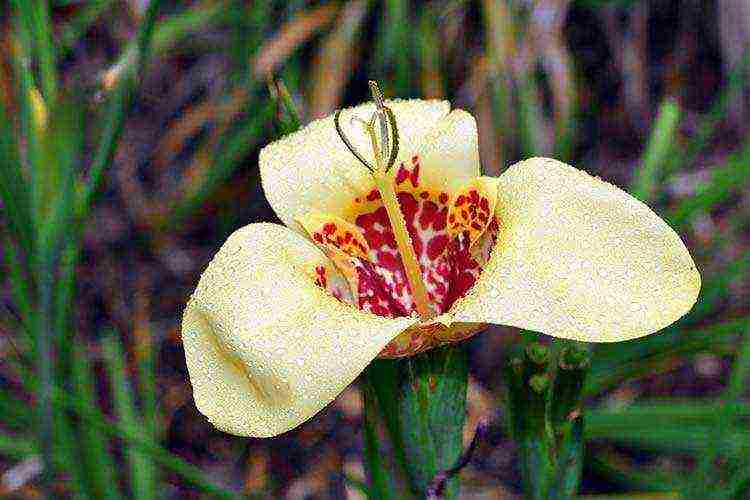 Tigrid flower.
Tigrid flower.
The gardens and summer cottages of our country are not very spoiled by this plant - many have not even heard such a name. But tigridia is a very popular ornamental plant in many countries, on all continents. Peacock tigridia is beautiful, has tasty, edible, corms and requires care akin to gladioli.
Tigridia belongs to corms. Its stem can be branched or simple, depending on the species. And the light green leaves of the xiphoid shape look folded. The greens of the peacock tigridia are not devoid of grace: sharp lanceolate leaves form numerous folds.
One or 2-3 flowers are located at the top of the peduncle. Flowers are short-lived - each lives only 8 hours in the morning. However, in general, the group of tigridia will retain their decorative effect for a long time, since new flowers bloom every day for a month and a half, starting from mid-July.
Help from Wikipedia
In Mexico, tigridia is cultivated for the sake of corms for food. This is the oldest culture in the region, cultivated by the Aztecs. Corms contain 21% starch, 13% glucose and 8% gum.
In his fundamental work "General History of New Spain Affairs" (1547-1577), Bernardino de Sahagun, relying on the information of the Aztecs about the properties of plants, cited various information about the peacock tigrid, in particular that:
There are others, also edible, called kakitl, they are used boiled. They have husks and leaves almost like bulbs, the flesh is white and edible, tastes like chestnuts. Also, cattail root is usually eaten boiled and raw. The roots of the edible chestnuts are called akashilotl.
In terms of landscape design, the most beneficial use of tigridia is to plant a group, separately from other plants, especially against the background of a lawn or conifers, as well as a single stone near a reservoir.
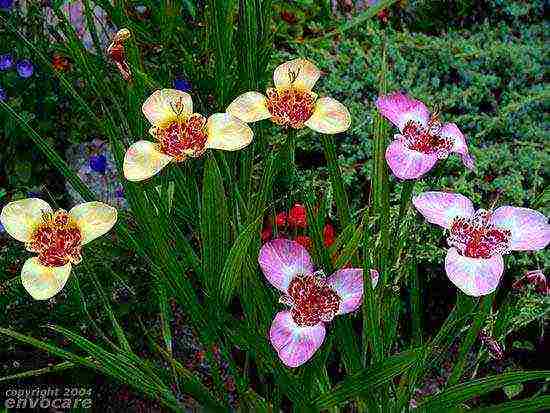 Tigridia in the garden.
Tigridia in the garden.
Tigridia looks good in flowerpots and large containers.
 Tigridium in Russia (Ust-Labinsk, Krasnodar Territory).
Tigridium in Russia (Ust-Labinsk, Krasnodar Territory).
The opened flower resembles an exotic, unusual tulip of white, yellow, orange, pink, lilac-red color with a variegated speckled center. In the beauty of the flower itself, tigridia can only compete with lilies and irises.
Flowers are located on strong straight or branching stems 25–65 cm high, in some varieties more than a meter. The flowers are decorated with a speckled cup-shaped core with carmine, red, yellow or pink spots and stripes. In large specimens, the core can reach a diameter of 6 cm.
Growing features Peacock tigridia.
Peacock tigridia.
The area for growing tigridia should be well lit and protected from cold winds. The plant does not tolerate return frosts well. The place is prepared in advance, applying fertilizers during digging.
The soil for it should be fertile, loose, neutral and moderately moist. Tigridia thrives on sandy and loamy soils.
Soil composition must necessarily include humus, peat, compost or manure, as well as ash and mineral fertilizers, acidic soils lime.
Excessive moisture is destructive for tigridia bulbs, therefore, when planting in soil or holes, sand or vermiculite is added under the bottom.
Landing time. Corms are planted at the end of the third decade of May, then the leaves will appear above the ground after the return cold weather. An earlier planting is also possible, if it is possible to shelter the seedlings from frost. It is undesirable to plant later, as the bulbs will irreversibly dry out.
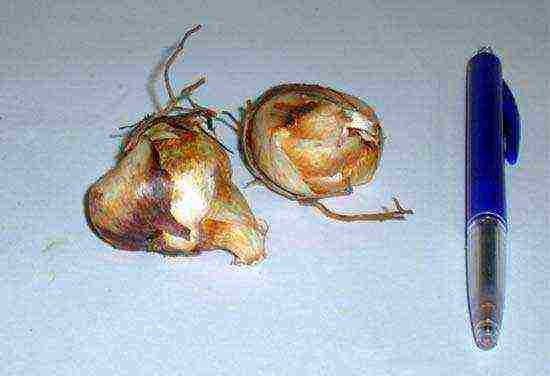 Peacock tigridia bulbs
Peacock tigridia bulbs
Planting depth of large tigridia bulbs is 8 cm. Small corms are planted closer to the surface of the earth. The preferred distance between adjacent plants is 15 cm.
In order for tigridia to bloom early and form full-fledged bulbs by next year, especially in the northern regions, it is recommended to grow tigridia for one to two months.
For growing corms of tigridia, they are planted in pots with a drainage hole and kept in a room on a windowsill. Before the arrow appears, the soil in the pots is occasionally moistened, and after the arrow appears, watering is increased.
To harden tigridia, in mid-April, pots with seedlings are taken out on a glazed balcony or in a greenhouse. Ready, grown tigridia are planted in open ground along with a lump of earth so as not to damage the root system.
Tigridia care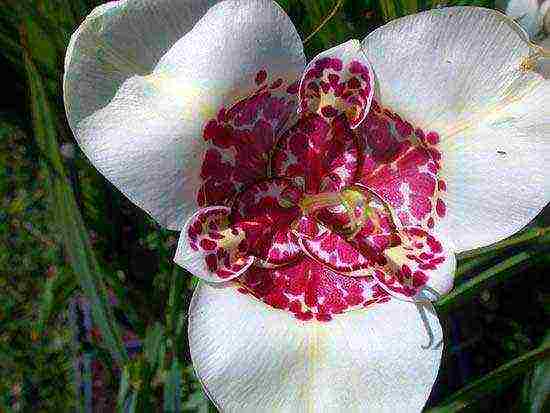 White tigridia.
White tigridia.
Caring for tigridia resembles caring for gladioli and consists in regular watering, especially in hot weather, periodic feeding, loosening, weed control, prevention and control of diseases and pests.
Pour warm water over the tigridia deep, so that the water reaches its roots. Shallow watering is harmful to the plant. To reduce the number of irrigations, as well as warm up the soil in early spring and autumn, protect against drought, and improve the quality of flowering, mulching the soil around the tigridia with peat, dry grass, sawdust, etc. will help.
Top dressing of tigridia carried out regularly - 1 time in 10-15 days. The easiest way is to use a complex, instant fertilizer. Fertilizer is applied at the root, combined with watering, or foliar feeding is carried out on the leaves. Flowering depends on the supply of nutrients to the bulbs.
Tigridia forms strong stems and does not need to be tied. Tying may be required when growing - thin stems can be broken by the wind.
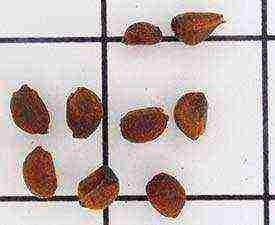 Seeds of tigridia.
Seeds of tigridia.
Withered flowers are removedso that seeds do not form and the corm is not depleted. When the main peduncle fades at the end of summer, dormant buds begin to wake up from below. New shoots have time to grow from them, and secondary flowering begins in September.
In the fall, you need to take care of the ripening of the tigridia corms. To do this, in early September with late flowering, and at the end of August with early flowering, remove all faded flowers and buds of tigridia. During this period, replacing corms of plants (3-5 corms) begin to form actively.
In order to extend the growing season of tigridia and give the opportunity to better ripen these corms, with the onset of frost, the tigridia is covered with a covering material or the tigridium planted in a container is brought to a cool place.
Winter storage Yellow tigridia.
Yellow tigridia.
At the end of September, the nests of tigridia corms formed are dug up for winter storage. Its stems are cut off, and the corms are laid to dry without dividing the nests.
Within 2 weeks, corms are kept at room temperature in a ventilated area. After the dried roots and leaves are cut off, leaving hemp of 2-3 cm at the leaves.
The corms are treated with any fungicide, for example, a 0.7% emulsion of foundationol or tincture of garlic (500 grams per liter of water). After the corms are additionally dried for 7-15 days.
Prepared corms are placed for storage, without disturbing the nests, in dry sand and stored in a cool dry place at a temperature of + 4— + 6 ° C.
If the storage place of the corms has high humidity, the corms are provided with air access and ventilation, for example, they are suspended in a nylon mesh.
In the spring, 3-5 days before planting, tigridia nests are divided into corms. The corms of tigridia, after the places of their breaks dry, are planted in open ground, containers or pots for growing.
Every gardener should know what planting and caring for tigridia outdoors is.
Each garden needs not only large fertile trees, but also bright colors, which are provided by numerous flower beds and a variety of flowering shrubs. There are many different colors that require different care and maintenance conditions. One of the most interesting and striking representatives is a flower called tigridia. The shape of the opened bud of this flower resembles an exotic butterfly, which is what attracts numerous gardeners. The only drawback of the plant is the fragility of flowering, which is only 1 day. Due to this, tigridia flowers are not found very often in flower beds.
Every gardener should know what planting and caring for tigridia outdoors is.
Each garden needs not only large fertile trees, but also bright colors, which are provided by numerous flower beds and a variety of flowering shrubs. There are many different colors that require different care and maintenance conditions. One of the most interesting and striking representatives is a flower called tigridia. The shape of the opened bud of this flower resembles an exotic butterfly, which is what attracts numerous gardeners. The only drawback of the plant is the fragility of flowering, which is only 1 day. Due to this, tigridia flowers are not found very often in flower beds.
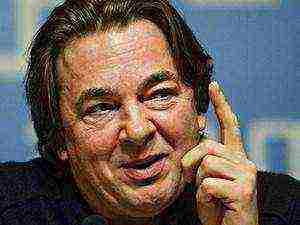 ErnstErnst: “I threw Malakhov to hell after the broadcast about“ sore joints ”! He dared ...
ErnstErnst: “I threw Malakhov to hell after the broadcast about“ sore joints ”! He dared ...
>>
Breeding and varieties of a flower
Tigridia is an incredibly beautiful bulbous perennial plant, the height of which reaches about 70 cm. Its stems are usually erect and simple, often slightly branching. In total, at least 4 fairly large flowers bloom on one plant, the diameter of which is more than 10 cm. A cup is folded from 3 large monophonic petals and 3 small inner ones. The inner petals look a little strange due to a certain spotted color. The flowers themselves can be of a wide variety of colors, ranging from white to bright red. The inner petals always appear brighter than the outer ones. The spotting is a bit like the color of a tiger, which is why the plant got such an interesting name.

This plant can please with its amazing flowering only for 1 day. Therefore, tigridium bulbs are recommended to be planted close to each other so that the glade will please the eye for at least a couple of weeks. And of course, we must not forget that about 5 flowers grow from 1 bulb. Therefore, for at least 3 days, even 1 flower will delight you with its beauty.
In most gardens and flower beds, you can find a lot of varieties of tigridia, of which there are at least 40 species. Not all representatives can be found in the markets, as they are very rare and listed in the Red Book. Still, it is not difficult to find this flower, because most of the species are presented for everyone to see and can be purchased for planting in their own gardens.
One of the most common varieties is the peacock tigridia. It is this type of plant that has ideally adapted to living conditions in the open ground and in the open air.Peacock tigridia, as a rule, reaches a height of 40-60 cm. The shape of the stem is cylindrical, and the leaves have an almost unique xiphoid shape. Peacock tigridia got its name due to its interesting core color, which is somewhat reminiscent of a peacock. Experts recommend planting them in groups of at least 10 bulbs. Peacock tigridia can perfectly decorate any garden and even an artificial reservoir.

Tigridia alba is an equally interesting variety. The variety resembles a daffodil due to its amazing white color. The main advantage of this plant is the huge flower size, which is more than 15 cm. The variety is quite in demand and easily takes root in open soil. Well, the last most striking species is tigridia canaryensis. The main feature of this variety is its very bright and variegated heart.
Growing process
From how correctly this plant will be planted, in the future it depends whether it will bloom or not. First you need to choose the right place for further disembarkation.

It is known that this plant variety is quite thermophilic. The tigridium flower requires as many areas as possible in which direct sunlight falls. Also, experts recommend choosing the quietest place for planting, where there are no winds and numerous drafts. The stems of the plant are very fragile and with strong gusts of wind they easily break, after which the flower ceases to function and does not grow any more.
Tigridia prefers loose and moderately moist soil. The most ideal option is loamy and sandy soil. But even it should be carefully prepared before disembarking. As a rule, peat, humus, ash and even mineral fertilizers are added to the soil, which can only be taken in specialized stores. If the soil does not meet the requirements and is too dense, you should loosen it and add at least a small amount of sand there. Thus, the permeability of moisture and air will become normal and sufficient for the life of the tigrid.
Experts recommend planting bulbs at the end of spring, when the risk of frost has passed. Of course, plants take root in the soil only if it is warmed up enough. The flower is very sensitive to temperature fluctuations, therefore it is very important that it grows in conditions of + 20 ° C and not lower. In the case of the appearance of the first shoots, watering should be increased, since it is at this time that the plant most of all needs additional moisture. The bulb is planted in open ground only together with an earthen clod. This will keep the root system in good shape.
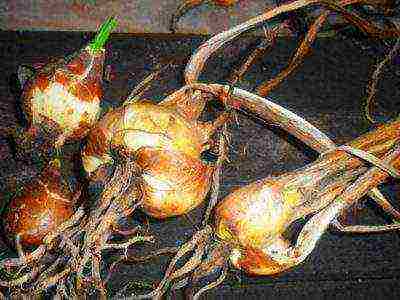
Before planting the bulbs in the soil, inspect them thoroughly. If you notice that mold, fungus, alien neoplasms and even rot have appeared on them, then it is better not to take risks and not plant them. Only healthy bulbs are intended for planting. To begin with, you should prepare holes, the depth of which should be no more than 20 cm. They must be well moistened. The distance between individual bulbs must be at least 20 cm on all sides. Many gardeners recommend preparing a so-called warm manure bed. Its presence will cause tigridia to bloom much earlier and provide abundant flowering.
Care advice
Tigridia, planting and caring for which is not particularly difficult, still requires adherence to some care recommendations. In order to get the desired result, experts advise to regularly produce sufficient, but not excessive watering, often loosen the soil and fertilize, do not forget about pruning already spoiled leaves and stems, and also take care of bulbs that have not yet been planted in the ground.
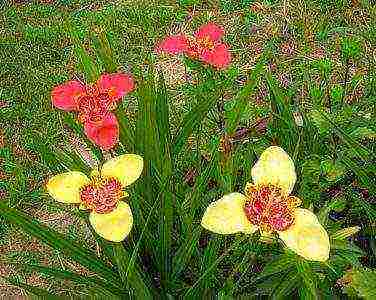
Watering should be repeated as the soil dries. At the end of spring, 1 watering per week will be enough for her.On the hottest days, this amount will increase at least 3 times. In addition, gardeners are advised to spray even the aerial part of the plant, otherwise it can dry out under the scorching sun in a matter of days. The water for irrigation should be slightly warm, so the tap liquid is suitable only after it has been heated. At the end of flowering, the dose of watering should be gradually reduced, thereby preparing the bulb for wintering.
Also, do not forget that every tigridia needs mineral feeding. Best of all, the plant perceives liquid complexes with necessary microelements dissolved in them. You can't overdo it either. The first feeding should take place during the period of active growth, namely when the first shoots become visible. The second fertilizer should be reproduced when the first buds appear. If done correctly, the flowering will be simply magnificent.
We must not forget about loosening the earth. This procedure will be especially relevant on hot days, when the soil is too dry and does not allow moisture to pass through. Subsequently, wilted leaves may appear, which must be cut off, otherwise the entire plant will die with it after a couple of days.
After the onset of the first frost, the bulbs should be carefully dug out so that they can delight with flowers next year. In this case, it is very important to follow all the rules for their storage.
If you want your garden to sparkle with new colors, plant such a unique plant as tigridia on the site. This flower will surely decorate your flower bed and surprise all guests with its splendor.
And a little about secrets ...
The story of one of our readers Irina Volodina:
Especially depressing for me were the eyes, surrounded by large wrinkles plus dark circles and swelling. How to remove wrinkles and bags under the eyes completely? How to deal with swelling and redness? But nothing makes a person look older or younger than his eyes.
But how to rejuvenate them? Plastic surgery? Recognized - not less than 5 thousand dollars. Hardware procedures - photorejuvenation, gas-liquid pilling, radiolifting, laser facelift? Slightly more affordable - the course costs 1.5-2 thousand dollars. And when to find all this time? And it's still expensive. Especially now. Therefore, for myself, I chose a different way ...
Read the article >>
The genus of Tigridia, for different data, belongs to either the Kasatikov family or the Irisov family, but still most scientists are inclined towards the first option.
This flower is quite exotic and is not yet very often grown, although in general caring for it is not particularly burdensome, and its decorative effect is high.
Varieties and types
The number of the genus is small, and only a few species are grown in culture, the most common of which is Peacock tigridia... This species is native to the central and southern regions of North America.
It is a bulbous perennial that grows up to half a meter or slightly taller. The foliage is xiphoid, folded. From one healthy tuber, up to five flower stems appear on each of which up to five buds can form.
The flower is six-lobed, large, multi-colored - the outer part of the perianth is usually purple with orange or deep red, the inner part is smaller, orange or, more often, spotted. Flowers appear and open in turn and thus flowering lasts almost a month, although the life of one inflorescence is only 9 hours.
The following varieties have been derived from this species:
- Viola - inflorescences are white with red,
- Aurea - yellow carmine petals,
- Canaryensis - the outer part of the flower is soft tones, and the inside is red,
- Lilacia - lilac petals with red and carmine blotches.
Tigridium tubular the shoot of this species is shorter than that of the Peacock, moreover, it branches well. The foliage is also smaller. Flowers of a delicate pink shade.
Tigridia Chess the name of the species speaks for itself - on the petals of this species, the spots are staggered.
to the table of contents
Tigridia planting and care in the open field
Caring for tigridia is not particularly burdensome, but still the flower is quite exotic and its cultivation has its own nuances. The site for planting should be selected well-lit, not blown by drafts.
When grown in warm regions where early planting can be done, the shoots of the plants will be stronger and can be done without supports, provided there is enough sun and no wind blowing.
Soils are preferably light, loose, nutritious, with drainage, the reaction is neutral, acidic soils are not welcome. If the substrate is too heavy, for example, clay, then it is mixed with sand, pebbles. Otherwise, caring for the plant is similar to caring for gladioli.
In warmer parts of the mainland, for example, in Ukraine, southern Russia and Belarus, planting can be carried out in the soil in late spring. The bulbs are completely deepened into the ground, and between the individuals they leave at least 15 cm.After a month or a little more, sprouts will begin to hatch. The bushes grow large, but they will begin to bloom only at the end of summer.
If you are interested in how gladioli are grown when planting and nursing in the open field, as well as many other recommendations for keeping this plant, read this article.
to the table of contents
Tigrid seedlings
It is worth noting that when planting directly into the soil in late spring, new bulbs do not develop very well, so even when living in warm regions, it may be advisable to plant in pots in advance.
In more northern regions, located at the level of St. Petersburg, it is better to plant early (in early spring) in pots and grow them before summer in greenhouses.
As a rule, tigridia bulbs are placed in pots in a mixture of peat, sand and turf, 3 pieces each. They are watered a little, and when the sprouts hatch, watering is intensified. Before being transplanted to a flower bed, they are grown in normal room conditions. If you do not carry out such a growth, then the shoots may begin to stretch up unnecessarily and they will have to be tied to supports.
At the beginning of summer, they are transplanted into open soil, often done together with a pot. It is advisable, before the procedure, to put 30 cm of horse manure mixed with foliage into the holes, and up the same amount of soil, and then lower the pot with the plant.
to the table of contents
Watering tigridia
Watering is carried out as the soil dries up; in the heat, the amount of liquid is increased. Water for irrigation should be warm and, preferably, deep watering.
That is, dig in a piece of a tube with holes next to the plant and pour water into it. Strong watering is needed during flowering.
to the table of contents
Fertilizers for tigridia
After planting, it is advisable to apply nitrogen fertilization at the rate of 35 g per 1 m2. A month after planting, a complete liquid mineral fertilizer is applied, the dose indicated on the package.
During budding, it is not bad to add nitrophosphate - 50 g per 10 liters of water for irrigation. Leaves can be sprayed with the same solution.
to the table of contents
Tigridia in winter
With the withering of the flowers, the shoot is cut off. This is necessary so that the bulbs are better prepared for the subsequent wintering. If the stems are too tall or topple over, be sure to make supports for them.
After the first light frost, the green part of the bushes will die, after which it is cut off, and the bulbs are dug out, carefully cleaning off part of the earth, but part is left - it will fall off later.
They are dried in the room for at least 30 days. 10-15 days after you begin to dry the material, the remnants of the earth are cleaned off from it, the roots are cut off, and the hemp is cut to 2 cm.
For dry storage, it is best to use sand. If the storage place is too damp, then it is better to simply hang the material in a nylon mesh.
In the spring, before planting, the tubers are separated.This is done 4 days before planting, because the places where the bulbs were pressed one to one should dry out.
to the table of contents
Tigridia growing from seeds
In southern latitudes, where flowering begins in the middle of summer, you can collect tigrid seeds and propagate the plant with them.
Sowing is carried out in the middle of winter, preliminary stratification, that is, treatment with low temperatures, is not required. Sowing is carried out in a mixture of sand and peat in a ratio of 1 to 1.
The substrate is not allowed to dry out, periodically watering it easily. Seedlings begin to hatch 10-20 days after sowing.
At the end of spring, seedlings can be planted in a flower bed, and by autumn the bulbs obtained from young plants will already be suitable for further propagation.
How to collect, store the bulbs and plant them, that is, about the vegetative method of reproduction, was mentioned above.
to the table of contents
Diseases and pests
When growing tigridia, you can face various problems. Most often, gardeners have to deal with rotten bulbs in winter... In order for the planting material to be better stored, it is treated with fungicidal preparations, for example, a weak solution of foundationol.
Occasionally occurs rust damage... Wherein red spots appear on the foliage... To combat this fungus, sore spots are cut off and a 1% solution of Bordeaux liquid or similar fungicides is used.
Lack of flowering It often happens when fertilizers with a high nitrogen content are applied on nutrient soils, while the foliage begins to grow strongly, and, on the contrary, does not bloom.
Tigridia bulbs love to eat bear... By affecting the root system of the plant, they destroy it. This pest can be detected by small piles of earth on the surface of the soil. It is best to deal with them with traps with dung, honey or beer. Also, having found a nest, you can fill it with soap and water. If there are too many pests, then they resort to chemicals.
Thrips feed on plant juices. This pest reproduces extremely quickly in warm weather, and in addition, it can infect many different plants. He leaves behind him yellow dry spots on foliagethat soon dies and dries up.
Due to thrips, flowering ends early. They fight this insect by spreading sticky paper around the plants and using infusions of tobacco, celandine, insecticides.
Sometimes tigridia is attacked slugs... To combat them, it is enough to scatter lime or crushed eggshell around the plants. Also, these pests can be harvested by hand.
to the table of contents
A bulbous herbaceous perennial plant, Tigridia, is a member of the Iris family. According to various sources, this genus unites 20–55 species. The range of this culture extends from Mexico in the north to Peru and Chile in the south. The name of this flower is derived from the Latin word tigris (in the genitive case - tigridis), which means "tiger", most likely, this is due to the variegated color of the perianths. Previously, the Aztecs lived in Mexico, they grew these flowers, because they have medicinal properties. In Europe, tigridia has been cultivated since the 16th century, but it has never been very popular with gardeners, most likely, this is due to the fact that such a plant blooms only in the first half of the day, and the life span of a flower is only 8 hours.
Features of tigridia
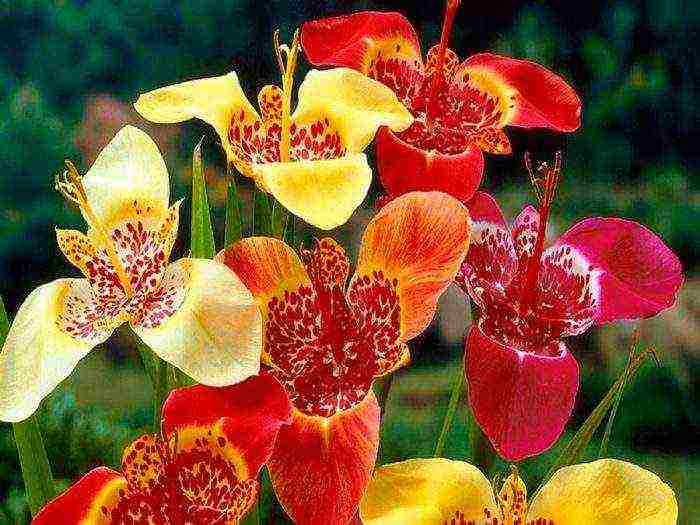
The height of the tigridia bush can vary from 0.3 to 0.7 m. This perennial bulbous plant can have branched or simple shoots. Evenly folded greenish leaf plates have a xiphoid shape. At the tops of the arrows, single flowers are located, and they can also be collected in 2 or 3 pieces. The flowers have a bizarre shape similar to an exotic butterfly.The fruit is a capsule with squeezed, angular seeds inside.
Planting tigridia in open ground
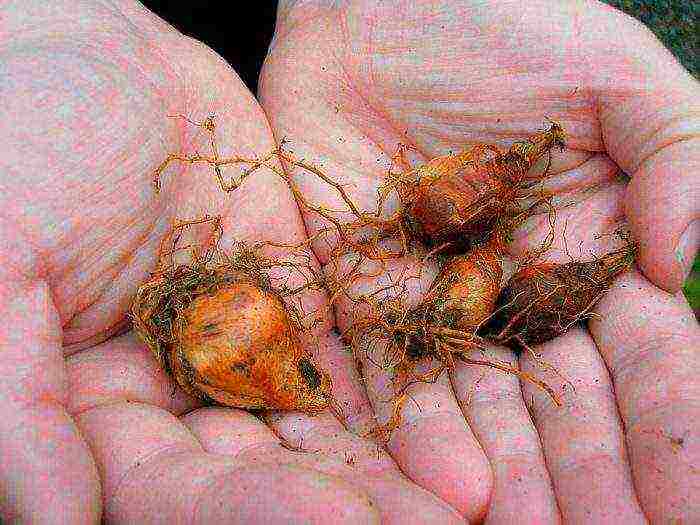
What time to plant
Since tigridia bulbs react extremely negatively to frosts, they should be planted in open soil only after warm weather has established, as a rule, this time falls on the last weeks of spring or the first - summer. For planting, choose a sunny, open area. It is possible to grow this culture in partial shade, however, in this case, the peduncles will become weak and thin, and therefore they will need a garter to the support. Also, the site must be protected from drafts and sudden gusts of wind, as they can injure the thin and weak shoots of this flower. A suitable substrate should be loose, light, moderately moist, well-drained and non-acidic. To fix excessively dense soil, you can add sawdust or sand to it.
Landing rules
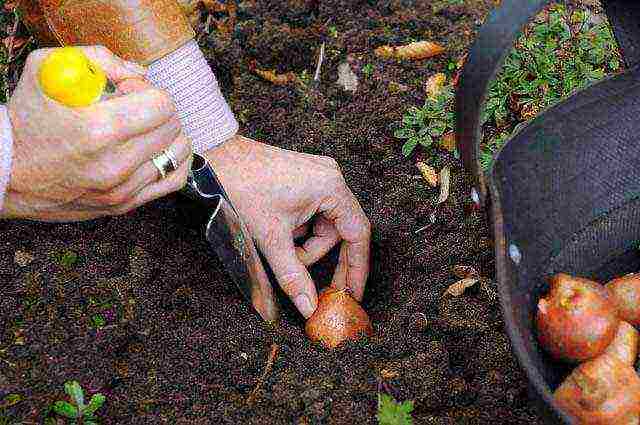
Immediately before planting, the planting material should be immersed in the Maxim solution for a couple of hours (for 1 liter of water, 2 milligrams). The bulbs treated in this way will be protected from fusarium, white and gray rot and other diseases. To what depth to plant the bulbs directly depends on their size. For example, the smallest bulbs need to be planted to a depth of about 50 mm, and the largest ones are buried in the soil by 100 mm. A distance of at least 15 centimeters should be maintained between the bulbs in a row, while the distance between the rows should be about 20 centimeters. The first shoots can be seen only after 30–40 days, the grown bushes will bloom in August, but as a rule, they do not have time to bloom before frost, which is extremely bad for the replacement bulbs. In this regard, experienced gardeners advise, before planting corms in open soil, to grow them indoors. To do this, in the last days of March, they are placed for distillation. More about this will be discussed in the section on transplanting this plant.
Caring for tigridia in the garden
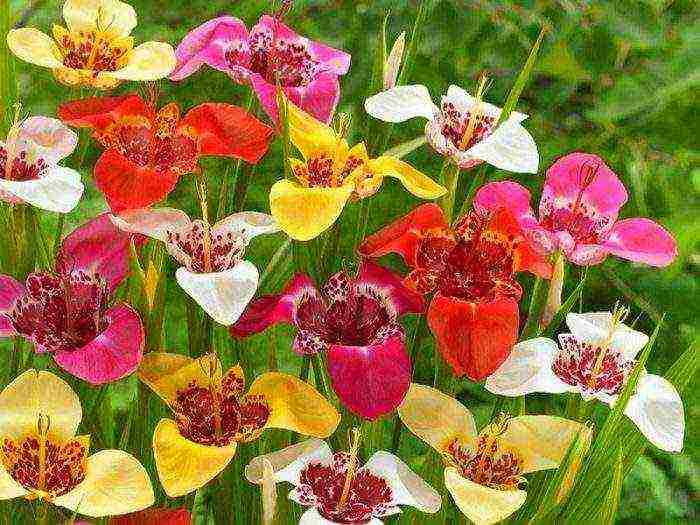
Growing a tigridia in your garden is quite simple. She needs to ensure timely watering, weeding, feeding and loosening the soil surface between the bushes. Experienced gardeners advise to cover the surface of the site with a layer of mulch, this will not only preserve the structure of the soil, but also reduce the number of watering, weeding and loosening. It will also be necessary to remove flowers that have begun to fade in time, and, if necessary, tie bushes to pegs or twigs.
How to water and feed
When grown in a garden, this plant needs systematic watering. During a prolonged drought, the bushes should be watered every day, while using such a volume of water so that the ground can get wet to the depth of the corms. Also, with prolonged drought, the aerial part of the bushes will need to be moistened from a spray bottle with lukewarm water in the evening.
If, in preparation for planting, all the necessary fertilizers were introduced into the ground, then it will be possible to forget about feeding the tigridia until the end of the season. If the soil is poor or depleted, then the bushes will need to be fed only a couple of times per season, and a solution of complex fertilizer is used for this (3 grams per 1 liter of water). Top dressing should be applied 4 weeks after the appearance of foliage and during budding.
Transfer
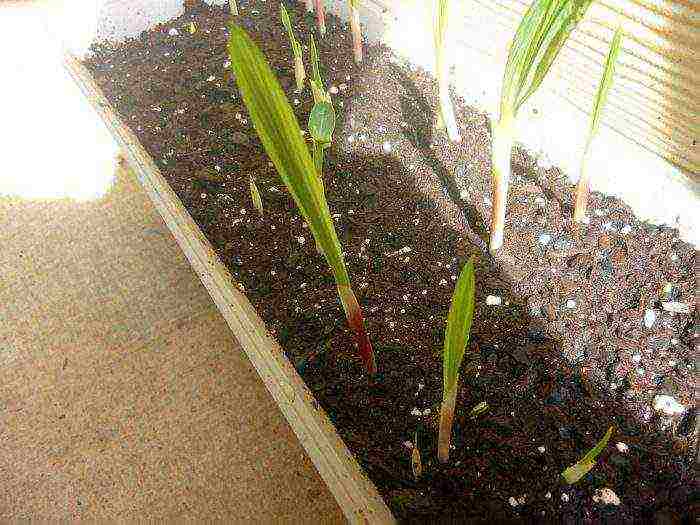
In order for the plants to bloom early, at the beginning of the spring period, the bulbs need to be grown indoors. They should be planted in the last days of March in a pot of light soil. 3 or 4 corms are planted in 1 pot at once, while they must be buried into the substrate by at least 30 mm. Bulbs will need to be watered moderately in the first weeks.After the corms begin to sprout, the abundance of watering must be increased, it should be taken into account that the substrate should get wet to the depth at which the roots of the corms are. It is best to choose pots with wide holes for drainage for planting corms, and the plate stand should be quite high so that the tigridia can be used for bottom watering. With such watering, the risk of developing fungal diseases is relatively lower. After the arrows appear, the containers with tubers must be transferred to a well-lit warm windowsill. Remember that drafts are contraindicated for these plants. These corms are planted in open soil in the first days of June.
The depth of the planting pit for the transplanted plant should be from 0.5 to 0.6 m.At the bottom of the pit, a drainage layer should be made of horse manure or broken brick, while its thickness should be from 0.2 to 0.25 m. it should be laid with a layer of loose soil of the same thickness as the previous one. Then it is necessary to place a sprouted corm on it, after which the hole is covered with nutritious soil. Transplanted plants need abundant watering.
Reproduction of tigridia

In the event that the bushes begin to bloom from mid to late July, then the seeds will be able to ripen before frost. Seeds are harvested before frost begins. Their sowing is carried out in the winter, while pre-sowing preparation is not needed for the seeds. The containers are removed in a well-lit, warm (from 20 to 25 degrees) place. When diving seedlings, you need to be very careful to avoid injury to their roots. After the seedlings develop a pair of true leaf plates, they should be cut into individual pots, while they are taken along with a lump of earth. From the moment of sowing to the beginning of flowering, it takes about 6-7 months.
Also, vegetative methods can be used to propagate this culture. During 1 season, one adult corm grows about five replacement children. They should be separated from the parent bulb before planting, while the places of breaks and cuts should be sprinkled with coal powder, after which the children can be planted in the soil.
Diseases and pests

Quite often, gardeners are unable to preserve the planting material of tigridia until spring, because most of it rots. As a rule, rot appears on those bulbs that are poorly ripe. That is why it is extremely important, before starting the preparation of corms, to make sure that they are well ripened. Also, for prevention purposes, it is imperative to poison the corms before storing them in any fungicidal solution, for example: Maxim, Benlate or Fundazole.
A plant grown outdoors can be affected by scab or rust. To prevent this, it is recommended to spray the foliage with plant infusions or fungicide solutions.
If the plant is affected by the mosaic, then it is no longer possible to cure it, since viral diseases are currently considered incurable. In this regard, it is extremely important to provide the plant with proper care and conditions suitable for growth so that it is strong and less sore.
Bears, slugs, cabbage scoops and thrips are capable of harming tigridia. To exterminate thrips, as well as the scoop, along with their caterpillars, the foliage of the bushes must be sprayed with a solution of any insecticide. Slugs are collected by hand in order to facilitate their work, pieces of slate or boards are laid out on the site, under which most of the gastropods slide down during the hot time of the day. Remove them from under the bait and destroy. And it is necessary to pour the soap solution into the discovered moves of the bear. If the bear tries to escape by getting out, it should be caught and destroyed.
Tigridia in winter

Storage preparation
Since tigridia is a thermophilic plant, it is possible to leave it for the winter in the open ground only in the warmest southern regions. Therefore, with the onset of autumn, most gardeners remove the corms from the soil and store them until spring, while choosing a cool enough place, but the temperature there should not drop below 0 degrees. However, digging up tigridia corms and storing them is not so simple. In order for the planting material to be well preserved until spring, it must be fully ripe, and for this you need to know exactly when to remove the bulbs from the soil in the fall. This procedure is carried out only after all the leaf plates on the bush wither. If there is a threat of frost, but the foliage is still green, it is recommended to dig the bushes together with a lump of earth, which must be large enough, then it is transferred to a cool and well-lit room. Only after the leaf plates turn yellow and wither, it will be possible to start harvesting the planting material for storage. Preparation of corms for storage includes their cleaning, rinsing, as well as etching in a solution of the Maxim preparation and thorough drying. Separation of children from parental bulbs should be done in the spring before planting, but not in the fall.
Storage rules
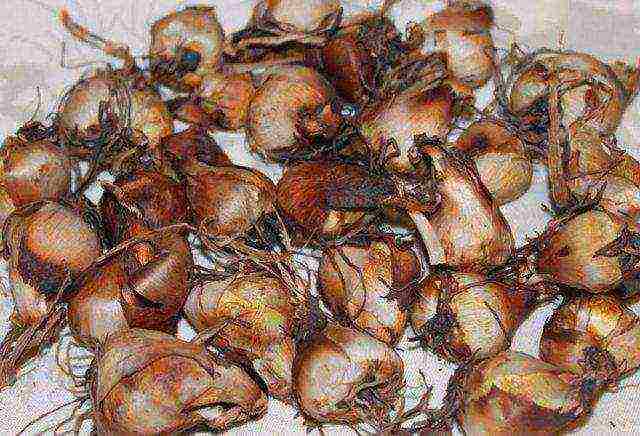
Corms should be placed in a container filled with dry sand or peat. They are stored for storage in a cool (3-10 degrees) room with normal air humidity. Also, the bulbs, if desired, can be folded into paper bags, which are removed on the refrigerator shelf intended for vegetables, where they will be stored until spring. During the winter, do not forget about the bulbs; a systematic check should be made, during which all spoiled and rotten bulbs must be discarded.
Types and varieties of tigridia
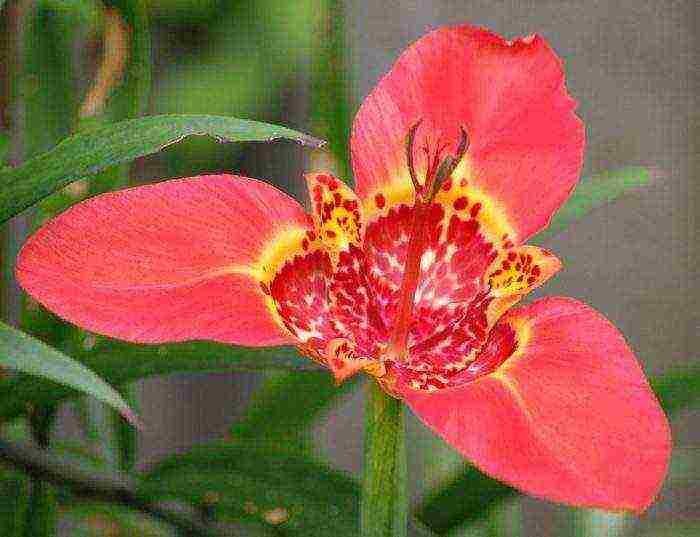 Peacock tigridia
Peacock tigridia
Gardeners cultivate only 1 type of this culture - peacock tigrid (Tigridia pavonia). This species is native to Mexico and Guatemala. The height of the bush can vary from 0.25 to 0.7 m. On the surface of the corms, which have an irregular shape, there are membranous scales. The bulbs are 60 mm long and about 40 mm in diameter. At the end of the growing season, there is a complete depletion of the old corms, but children grow up in it, which form nests. In the parent corm, the number of children and scales on the surface is almost the same. From one bulb, 3-5 peduncles will grow, and about 5 flowers are formed on each of them. Greenish wide leaf plates folded along the length have a xiphoid shape. The flowers, reaching 10-15 centimeters across, consist of 6 lobes that open alternately. In the perianth, the outer lobes are colored orange-violet or deep red, and the inner ones are not as large as the outer ones, they have an orange-yellow spotted color, like the pharynx. Tigridia blooms in July – August, with the life span of each flower being 8–10 hours. In general, the duration of flowering is about 2–3.5 weeks. Garden forms:
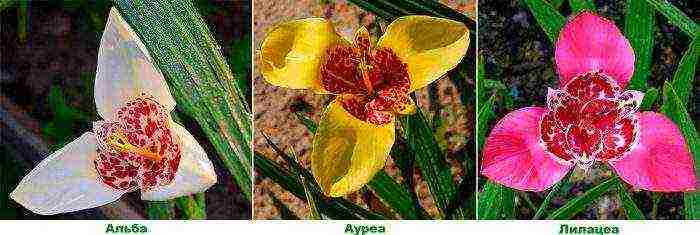
- Alba... The flowers are white, and there are red spots on their surface.
- Aurea... There are carmine spots on the surface of the dark yellow flowers.
- Carminea... The flowers are orange, covered with yellow spots.
- Lilacea... Carmine specks are located on red-purple flowers.
- Rosalind... The color of the flowers is pale pink.
- Canaryensis... The yellowish flowers have a rich red center.
- Speciosa... The color of the flowers is scarlet-red, and they have yellow-golden spots on them.
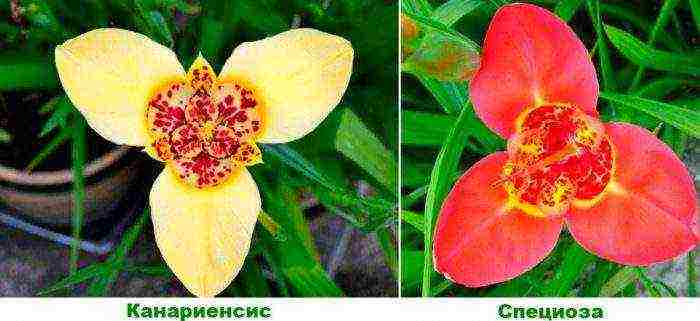
The variety mixture "Tigridia Ferraria mixed" is quite popular: the height of the bush is about 0.6 m, the leaf plates have a xiphoid shape, the flowers reach 15 centimeters in diameter, their outer petals are monochromatic (lilac-pink, white, red, orange or yellow) , there are spectacular specks on the three inner petals. Specialists engaged in breeding use in their work Mexican tigridia with yellow flowers, tubular tigridia with pinkish flowers and tigridia selerianu - lilac-blue flowers.And they also use other types that are not independently grown by gardeners.


